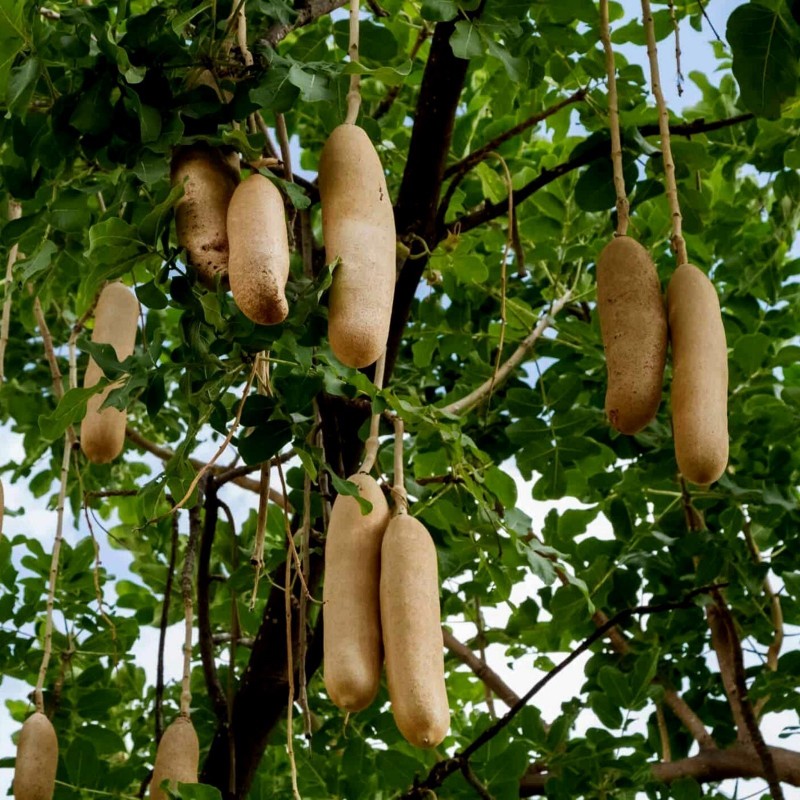















Kigelia is a genus of flowering plants in the family Bignoniaceae. The genus consists of only one species, Kigelia africana, which occurs throughout tropical Africa, from Eritrea and Chad south to northern South
Kigelia is a genus of flowering plants in the family Bignoniaceae. The genus consists of only one species, Kigelia africana, which occurs throughout tropical Africa, from Eritrea and Chad south to northern South Africa, and west to Senegal and Namibia. Common in India, with many medicinal uses, the species's distribution is most certainly anthropogenic. The sausage tree grows a fruit that is up to 2 feet long, weighs about 15 lbs, and looks like a sausage.
The genus name comes from the Mozambican Bantu name, kigeli-keia, while the common names sausage tree and cucumber tree refer to the long, sausage-like fruit. Its name in Afrikaans worsboom also means sausage tree, and its Arabic name means "the father of kit-bags".
Habitat
It is a tree growing up to 20 m (66 feet) tall and it typically has spreading branches. The bark is grey and smooth at first, peeling on older trees. It can be as thick as 6 mm on a 15-cm diameter branch. The wood is pale brown or yellowish, undifferentiated and not prone to cracking.
Foliage
The tree is evergreen where rainfall occurs throughout the year, but deciduous where there is a long dry season. The leaves are opposite or in whorls of three, 12 to 20 inches (30–50 cm) long, pinnate, with six to ten oval leaflets up to eight inches (20 cm) long and 2.25 inches (6 cm) broad; the terminal leaflet can be either present or absent.
Flowers
The flowers (and later the fruit) hang down from branches on long flexible stems (2–6 metres long). Flowers are produced in panicles; they are bell-shaped (similar to those of the African tulip tree but broader and much darker and more waxy), orange to maroon or purplish green, and about four inches (10 cm) wide. Individual flowers do not hang down but are oriented horizontally.
Fruit
The fruit is a woody berry from 12 to 39 inches (30–100 cm) long[3] and up to seven inches (18 cm) broad, but eight inches (20 cm) has been reported.[4] Typically it weighs between 11 and 22 pounds (5 and 10 kg) but occasionally up to 26 pounds (12 kg),[5] and hangs down on long, rope-like peduncles. The fruit pulp is fibrous, containing many seeds.
Species associations
Some birds are attracted to the flowers and the strong stems of each flower make ideal footholds. Their scent is most notable at night indicating that they are adapted to pollination by bats, which visit them for pollen and nectar. The flowers also remain open by day however, and are freely visited by many insect pollinators, particularly large species such as carpenter bees. The fruit are eaten by several species of mammals, including baboons, bushpigs, savannah elephants, giraffes, hippopotamuses, monkeys, and porcupines. The seeds are dispersed in their dung. The seeds are also eaten by brown parrots and brown-headed parrots, and the tree's foliage by elephants and greater kudu (Joffe 2003; del Hoyo et al. 1997). Introduced specimens in Australian parks are very popular with cockatoos.
Cultivation and uses
The fresh fruit is poisonous and strongly purgative; fruit are prepared for consumption by drying, roasting or fermentation (Joffe 2003; McBurney 2004). Kigelia is also used in a number of skin care products. In Botswana, the timber is used for makoros, yokes and oars.
The hard shell (skin) of the fruit can be hollowed out, cleaned, and made into useful, durable containers of varying sizes.
The tree is widely grown as an ornamental tree in tropical regions for its decorative flowers and unusual fruit. Planting sites should be selected carefully, as the falling fruit can cause serious injury to people and damage vehicles parked under the trees.
In Central Kenya, especially among the Agikuyu and the Akamba, the dried fruits are used to make an alcoholic beverage (muratina in Kikuyu, kaluvu in Kamba), which is a core component in cultural events in Central Kenya. The fruit is harvested then split into two along the grain, then dried in the sun. The dried fruit is then treated with bee pollen and honey. The treated fruit (miatine) is then used in fermentation process in making of sweet beer.
Data sheet

 Reviews (0)
Reviews (0)